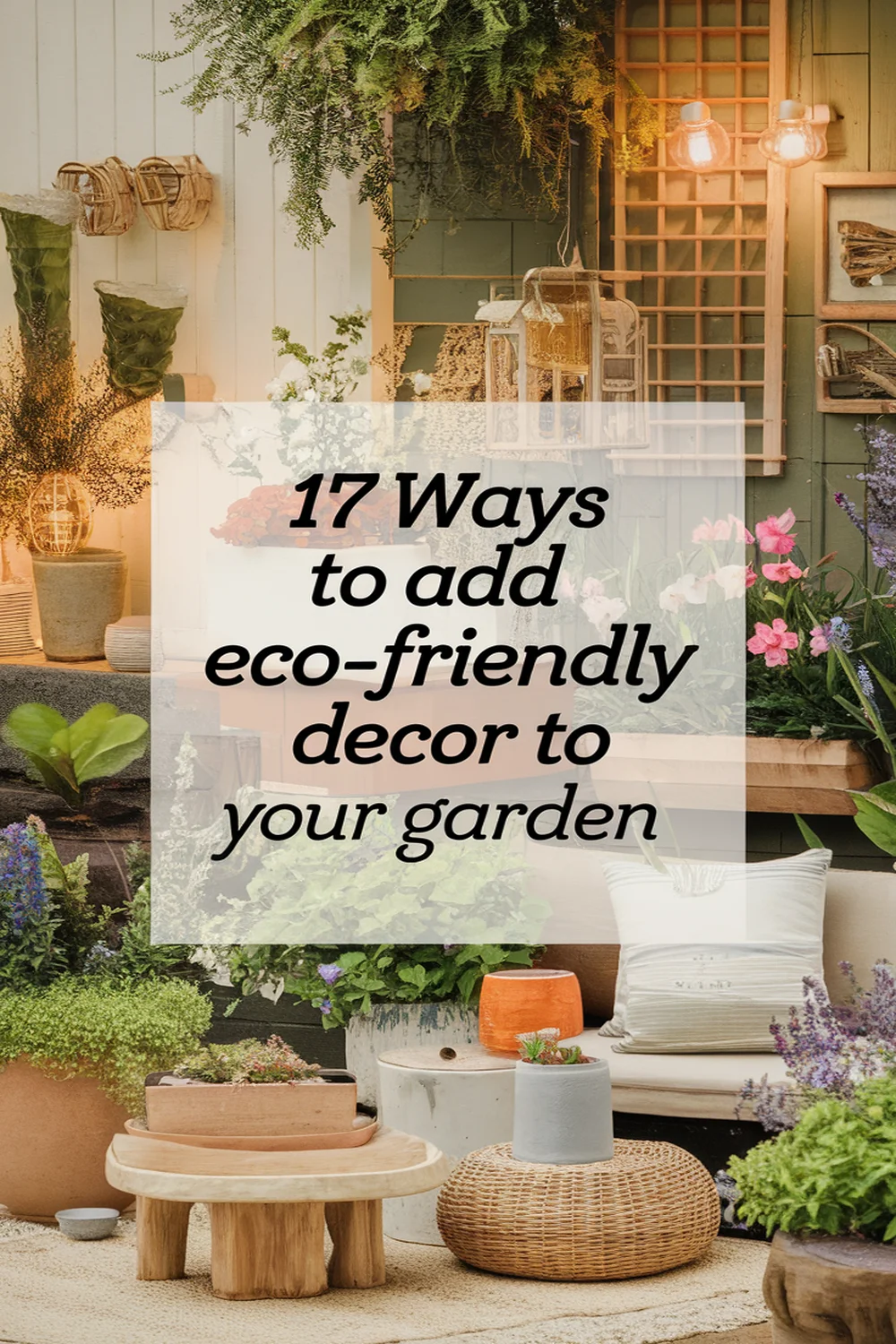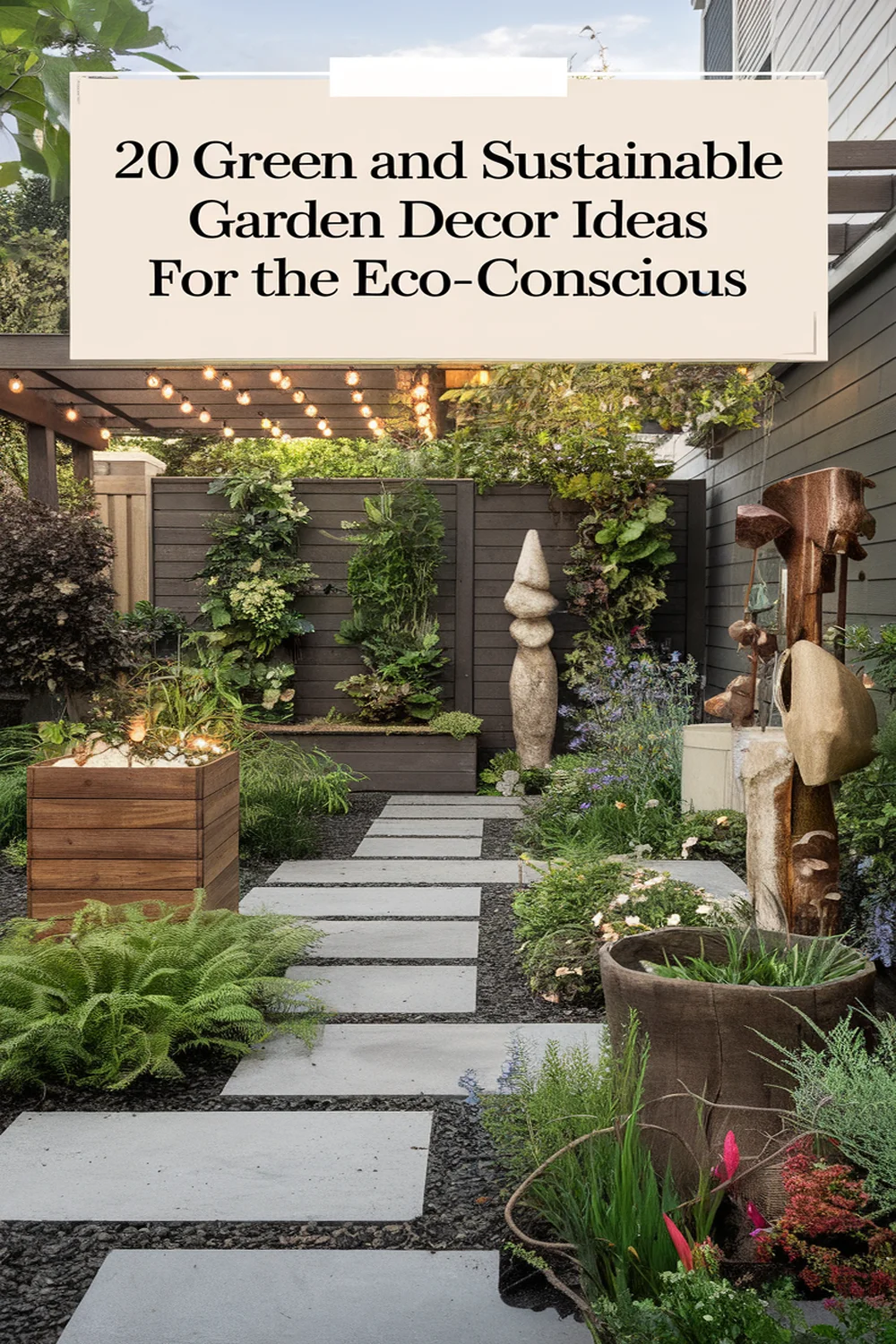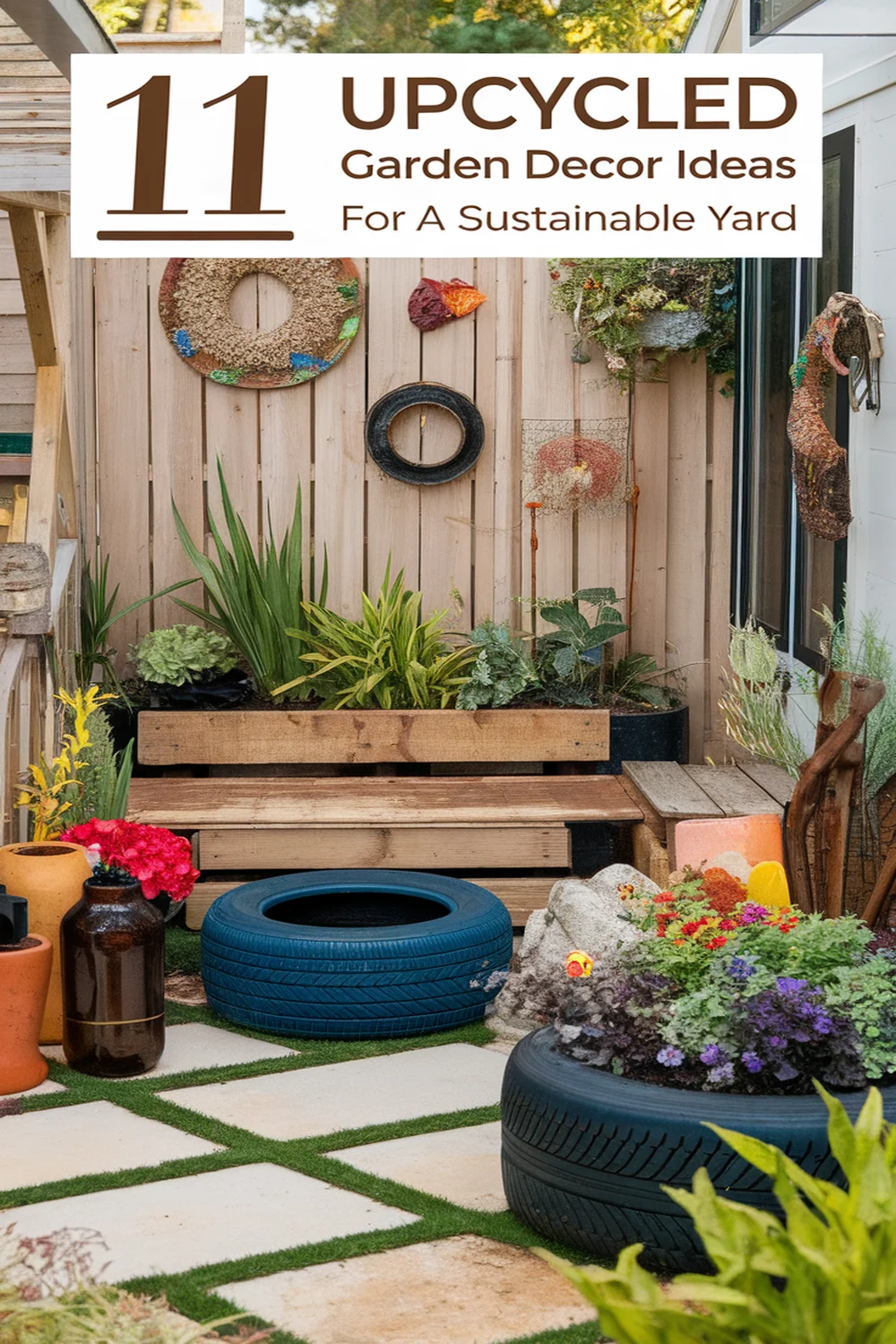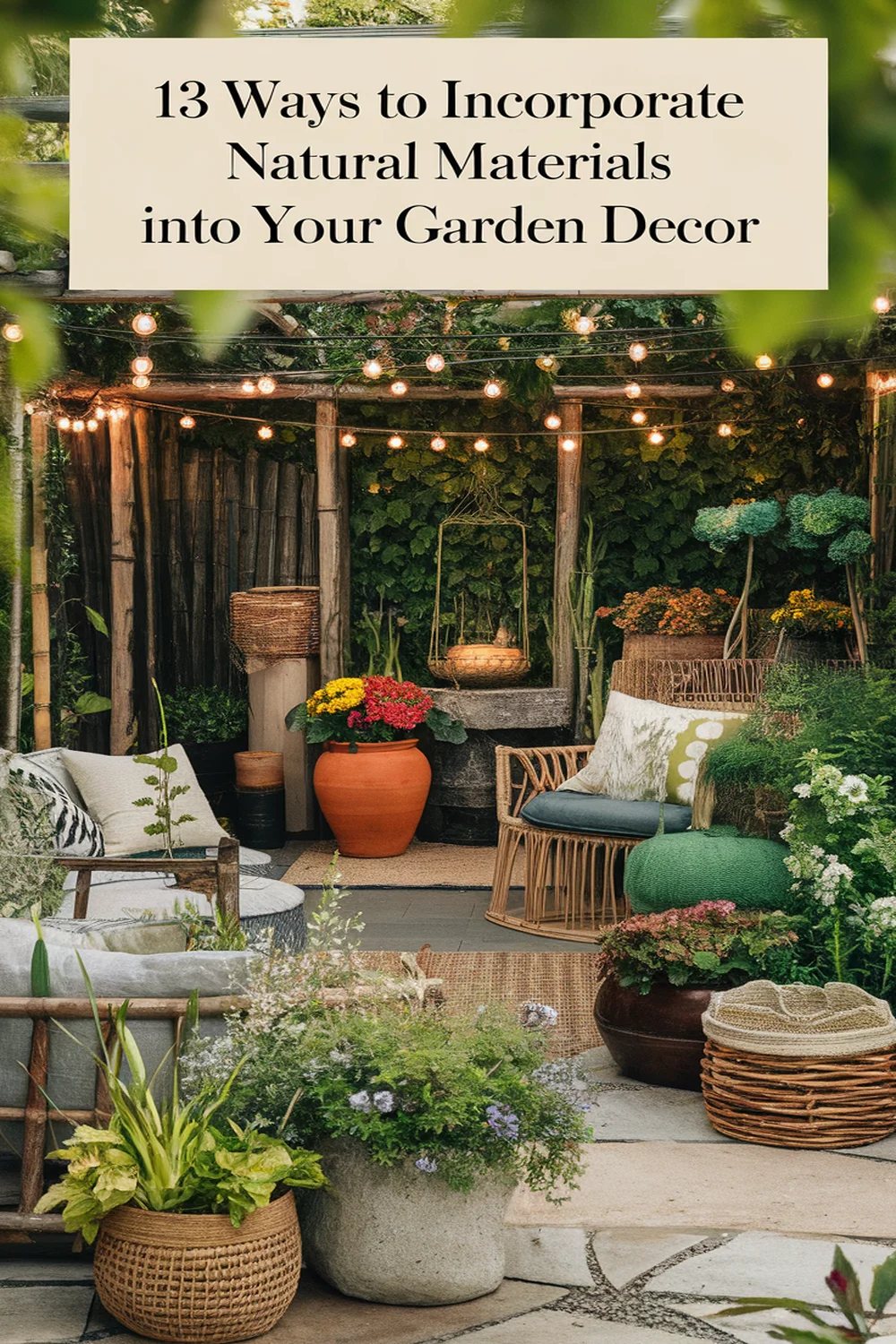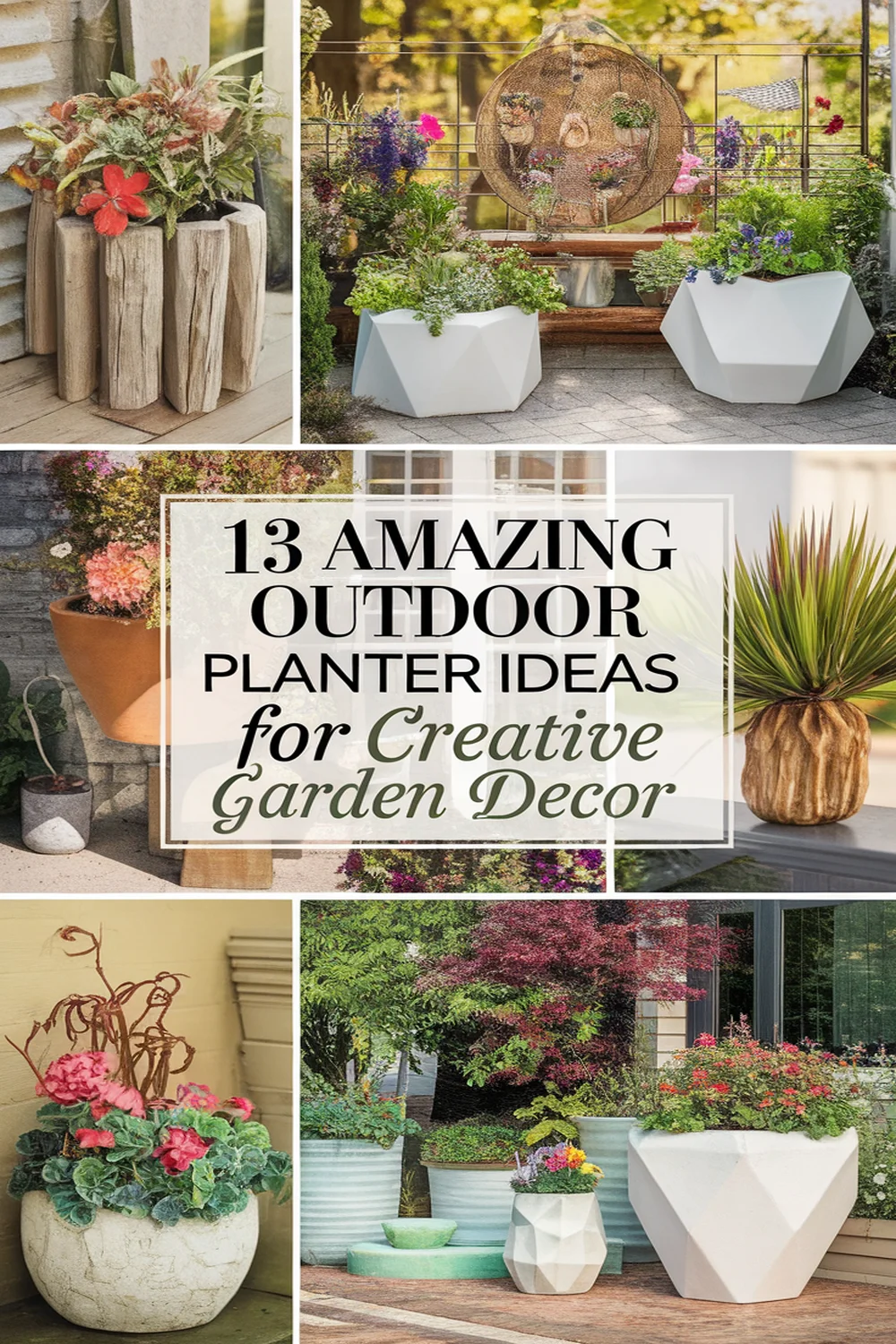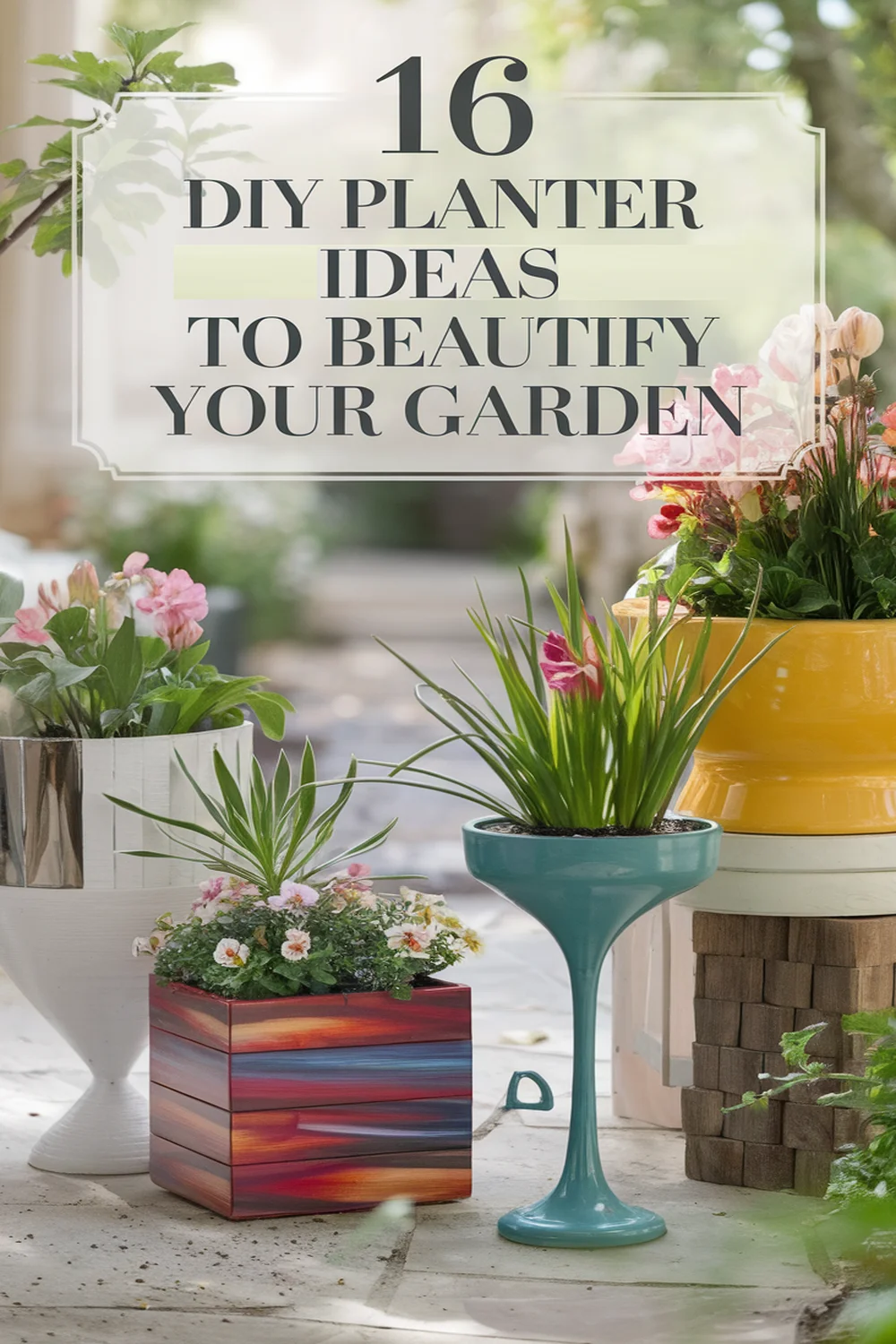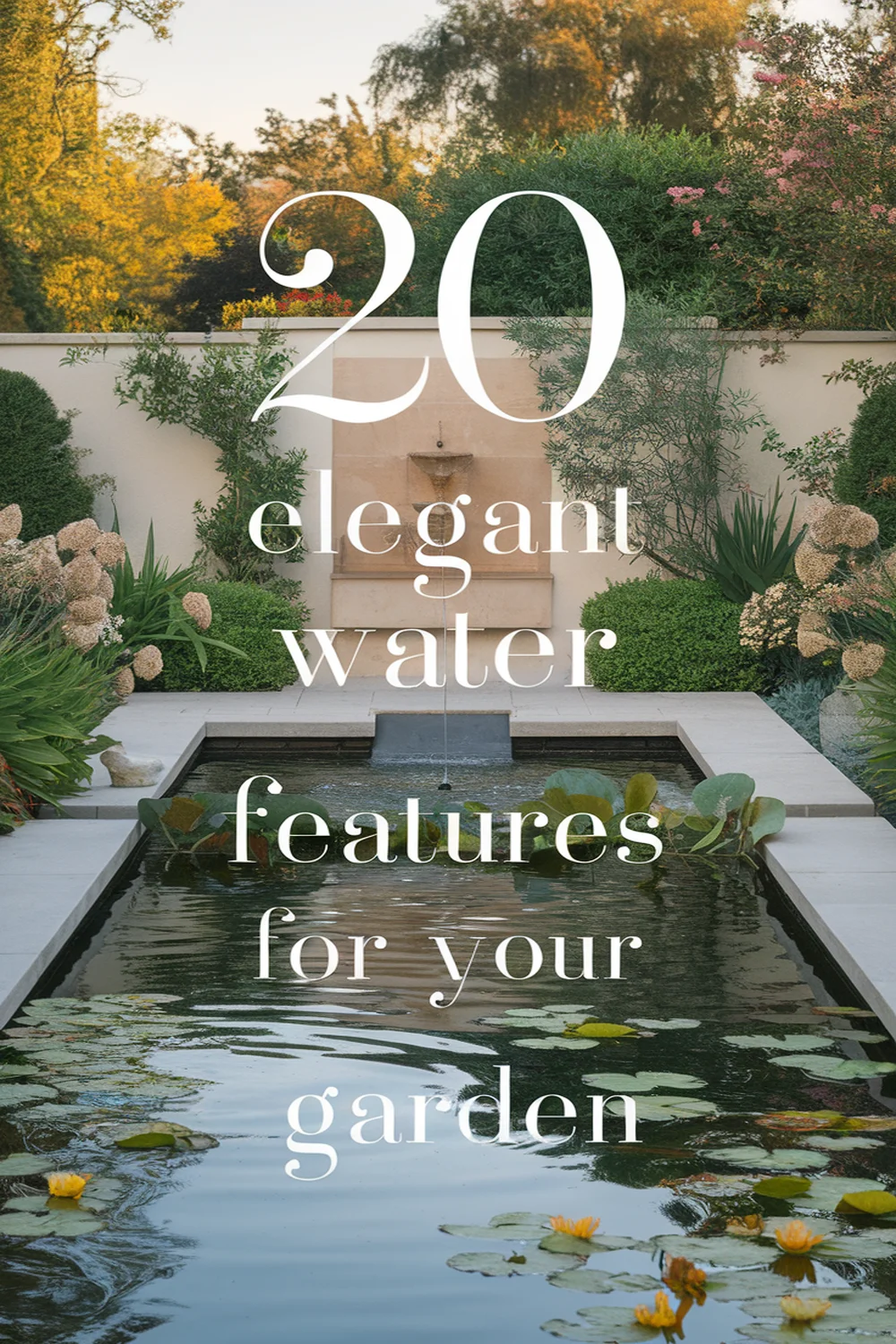This post may contain affiliate links. Please read our policy page.
You can transform your garden into an eco-friendly haven by using recycled materials for art, incorporating native plants to boost biodiversity, and building a compost bin for organic waste. Don’t forget to create a rainwater harvesting system, add solar-powered lighting, or install a drip irrigation system for efficiency. Consider a herb spiral for space-saving and embrace permaculture principles for sustainability. There’s more you can do to make your garden a greener space, so keep exploring!
Use Recycled Materials for Garden Art

When you transform everyday discarded items into stunning garden art, not only do you express your creativity, but you also contribute to a healthier planet. Think about using old tires, glass bottles, or wooden pallets as your canvas. You can paint those tires vibrant colors to create whimsical planters or stack pallets to form unique vertical gardens. Even broken dishes can find new life as charming mosaic decorations. By adding these pieces, you’ll infuse personality into your green space while reducing waste. Don’t underestimate the visual impact of your eco-art; every object tells a story. Plus, making garden art with recycled materials allows you to connect with nature and nourish your soul, all while fostering a sustainable future. Get creative!
Incorporate Native Plants for Biodiversity

By incorporating native plants into your garden, you not only create a thriving ecosystem but also support local wildlife. Native species are well-adapted to your climate and soil, requiring less water and fewer resources, making them a sustainable choice. They attract a variety of pollinators, such as bees and butterflies, which are essential for maintaining biodiversity. Consider adding plants like coneflowers, milkweed, or asters, which flourish in your environment. These selections offer vibrant colors and textures, bringing life to your garden. Embrace the seasons by choosing a mix of perennials and annuals that bloom at different times. You’ll cultivate a landscape that not only looks beautiful but also fosters a rich habitat for indigenous creatures, enhancing your garden’s overall health and resilience.
Build a Compost Bin for Organic Waste
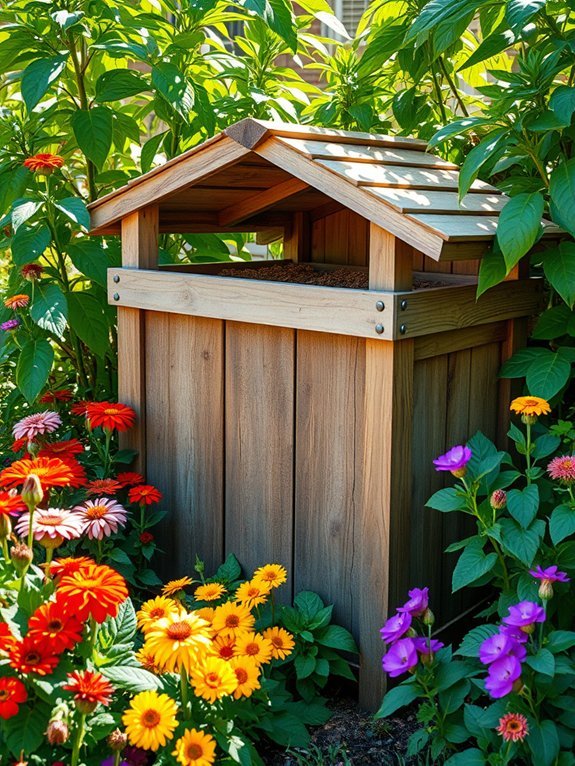
Creating a compost bin for your organic waste not only reduces landfill contributions but also enriches your garden’s soil naturally. Start by selecting a suitable location—choose a spot that’s easily accessible yet out of direct sunlight. You can build a simple bin using wooden pallets, wire mesh, or even repurposed containers. Layer your organic waste; include kitchen scraps like vegetable peels and coffee grounds, alongside yard waste like grass clippings and leaves. Turn the pile regularly to aerate it and speed up decomposition. Keep it moist, but not soggy. In a few months, you’ll have rich, dark compost ready to feed your plants. This not only benefits your garden’s health but also supports sustainable practices.
Create a Rainwater Harvesting System
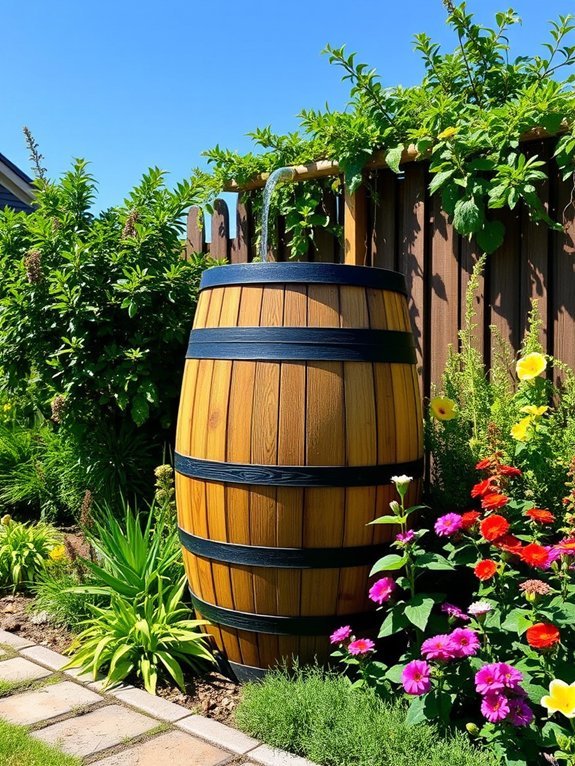
Rainwater harvesting systems are a fantastic way to make the most of nature’s resources while reducing your water bill. By collecting rainwater, you’re not only conserving water but also enhancing your garden’s sustainability. Here’s how you can set yours up effectively:
- Choose Your Collection Method: Decide between a barrel, cistern, or designed gutter systems to direct rainwater into your storage unit.
- Install a Filtration System: This guarantees that leaves and debris don’t compromise the quality of your collected water.
- Use a Pump or Gravity Flow: Depending on the size of your garden, either install a pump or utilize gravity to distribute the collected water.
Embrace this eco-friendly practice, and watch both your garden and savings flourish!
Install Solar-Powered Lighting
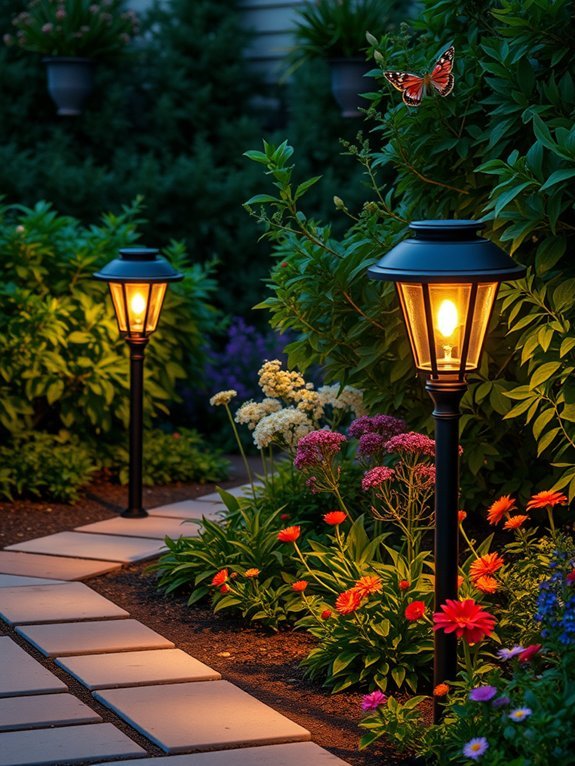
There’s something magical about transforming your garden into an enchanting nighttime escape, and installing solar-powered lighting can do just that. These eco-friendly lights harness the sun’s energy during the day, saving you money on electricity bills while keeping your garden illuminated at night. You can choose from a variety of styles, like string lights, lanterns, or pathway lights to create the perfect atmosphere.
Position them strategically to highlight your favorite plants or define pathways, ensuring safety and aesthetic appeal. Just make sure they’re placed in sunny spots to maximize charge. With minimal installation and maintenance, you’ll enjoy a soft glow that invites evening gatherings and peaceful reflection, all while being kind to the planet. Let your garden shine!
Utilize Upcycled Planters
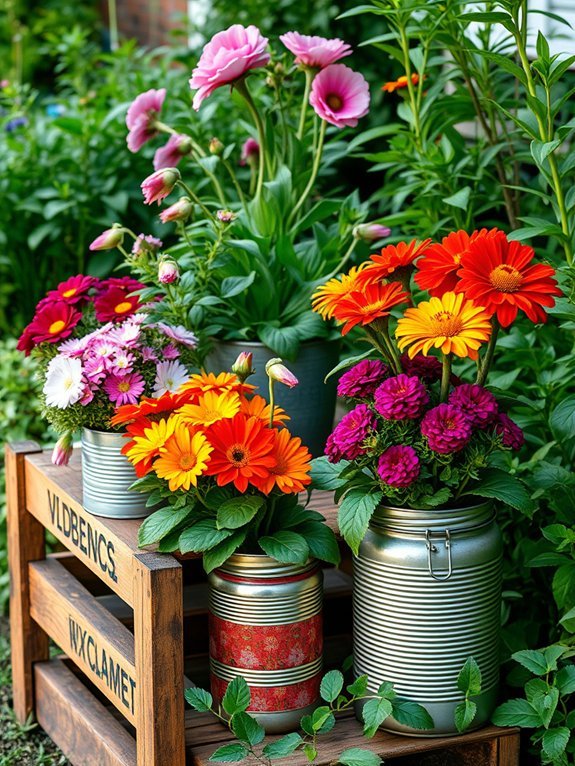
While you might think beautiful planters must come from a garden store, upcycling everyday items can add unique charm to your garden without harming the environment. By using items you already have, you not only reduce waste but also express your creativity. Consider these three ideas:
- Old Tires: Paint them in vibrant colors and arrange them in fun patterns for eye-catching plant displays.
- Wooden Crates: Stack or hang them up for rustic vertical gardening that maximizes space while being eco-friendly.
- Tea Cups: Use mismatched or chipped cups to create quirky mini-planters for succulent or herb arrangements.
Embrace your resourcefulness and watch your garden transform into a stunning haven with these upcycled treasures!
Designate a Pollinator-Friendly Area

Creating a pollinator-friendly area in your garden not only supports essential ecosystems but also enhances the beauty of your outdoor space. To attract bees, butterflies, and beneficial insects, consider planting a variety of native flowers. They provide food sources and shelter for these crucial creatures.
Here’s a quick guide to help you choose the best plants:
| Flower | Attracts |
|---|---|
| Purple Coneflower | Pollinators |
| Milkweed | Monarch Butterflies |
| Bee Balm | Bees |
| Black Eyed Susan | Various Pollinators |
Complement these plants with natural elements like water sources and sheltering stones. A dedicated pollinator-friendly area fosters biodiversity while turning your garden into a vibrant haven.
Employ Organic Mulching Techniques

After establishing a pollinator-friendly area, it’s time to think about how to keep that vibrant ecosystem thriving with organic mulching techniques. Mulching not only enhances your garden’s beauty but also maintains soil health and moisture. Here are three organic options you can use:
- Wood Chips: Break down slowly and enrich the soil over time; they suppress weeds effectively.
- Straw or Hay: Naturally biodegradable, these materials provide insulation and help retain moisture during dry spells.
- Grass Clippings: An excellent nitrogen source, they decompose quickly and create a nutrient-rich layer for plants.
Integrate a Vertical Garden

If you’re looking to maximize your garden space while adding a stunning visual element, integrating a vertical garden can be the perfect solution. These green walls not only save space but also bring life to any area, making even small patios feel lush. You can use various containers, trellises, or wall-mounted systems, filled with herbs, succulents, or flowering plants. This approach simplifies gardening, as vertical gardens typically require less soil and can be easier to maintain. Plus, they enhance air quality and support local biodiversity. To make it eco-friendly, consider using reclaimed materials for your setup and compost for your plants. Immerse yourself in this creative endeavor and enjoy the beauty and sustainability of your stunning vertical garden!
Create a Natural Wildlife Habitat

While you might think a garden is just for plants, it can also be a vibrant sanctuary for wildlife. By creating a natural habitat, you’ll invite beneficial creatures to thrive. Here’s how to do it:
- Plant Native Species: Choose flora that naturally grows in your region. This not only supports local ecosystems but also reduces maintenance.
- Create Shelter: Incorporate elements like birdhouses, bee hotels, or log piles. These provide safe spaces for critters to rest and nest.
- Add Water Sources: A small pond or birdbath can attract a variety of wildlife. Make certain it’s shallow for easy access.
Transform your garden into a wildlife haven, and you’ll enjoy the beauty and benefits of a thriving ecosystem right at home!
Opt for Natural Stone Pathways
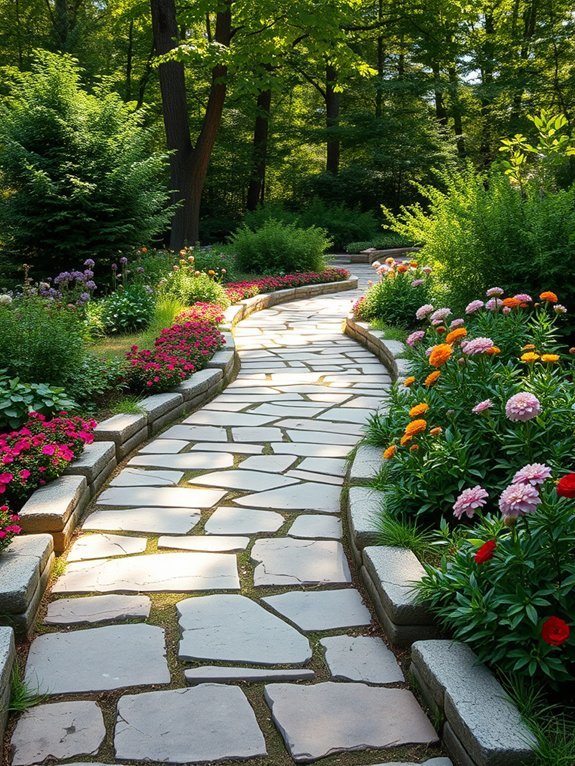
Natural stone pathways not only guide your steps through the garden but also enhance its organic beauty. By choosing materials like slate, granite, or limestone, you can create a rustic yet refined look that blends seamlessly with nature. These stones are durable and environmentally friendly, requiring little maintenance while standing the test of time. To craft your pathway, think about contrasting colors and textures, laying stones in patterns that reflect your garden’s personality. You can fill gaps with moss or gravel, adding charm and improving drainage. As you walk along these natural stones, you’ll appreciate how they ground your outdoor space, inviting both you and wildlife to explore and enjoy the tranquility of your eco-conscious retreat.
Recommended Items
Discover our top picks for eco-friendly decor that will transform your garden into a sustainable oasis!
Products
Install a Living Wall

Transforming your garden into a lush sanctuary becomes effortless when you install a living wall, which adds both beauty and functionality to your outdoor space. By creating a vertical garden, you’re not only enhancing aesthetics but also making a positive environmental impact. Here’s how to get started:
- Choose the Right Plants: Opt for a mix of flowering plants, herbs, and even succulents to guarantee a vibrant and diverse wall.
- Select a Support System: Use sturdy frames or modular panels that suit your space and allow for easy plant arrangements.
- Irrigation Considerations: Implement a drip irrigation system to keep your plants healthy while conserving water.
With these steps, you’ll enjoy a stunning living wall that breathes life into your garden!
Use Biodegradable Garden Accessories

Incorporating biodegradable garden accessories can make a significant difference in promoting sustainability, as these eco-friendly options break down naturally without contributing to landfill waste. Consider using items like bamboo plant stakes, jute twine, and natural fiber gardening gloves. These materials not only reduce your carbon footprint, but they also enhance the aesthetics of your garden. Replace plastic pots with biodegradable seedling trays made from compostable materials, allowing your seedlings to thrive and enrich the soil as they decompose. Opt for organic mulch made from shredded leaves or bark, which adds nutrients to the earth while suppressing weeds. By making these thoughtful choices, you’re not just beautifying your garden; you’re nurturing a healthier planet for future generations.
Create a Herb Spiral for Space Efficiency
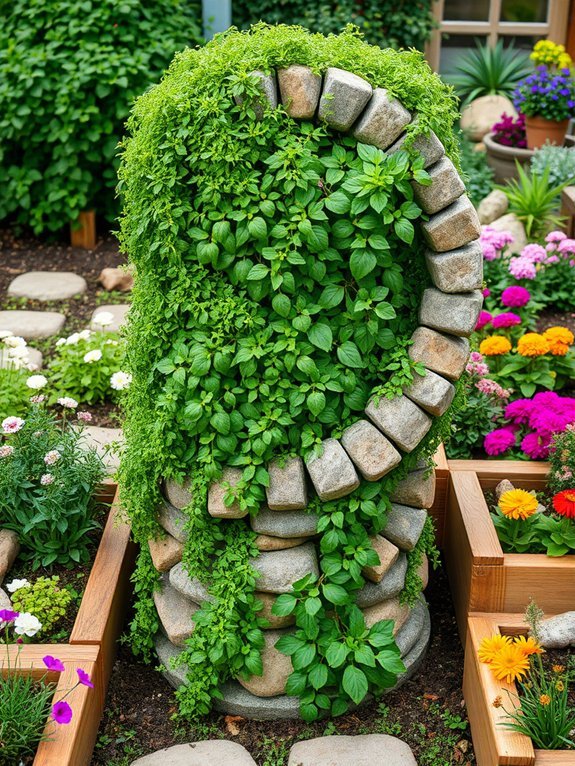
As you design your garden, creating a herb spiral can maximize space and provide a stunning focal point. This vertical garden structure not only looks beautiful but also allows you to grow various herbs in a small area. By taking advantage of microclimates, you can cultivate diverse plants that thrive at different heights and conditions.
Here’s how to make the most of your herb spiral:
- Layering: Plant herbs that need more moisture at the bottom and drought-resistant ones at the top.
- Companion Planting: Choose herbs that benefit each other, enhancing flavor and growth, like basil with tomatoes.
- Accessibility: Design it with easy access, so you can always snip fresh herbs for your meals.
Enjoy the lush bounty!
Eco-Friendly Garden Decor Action Steps
Embrace Permaculture Principles
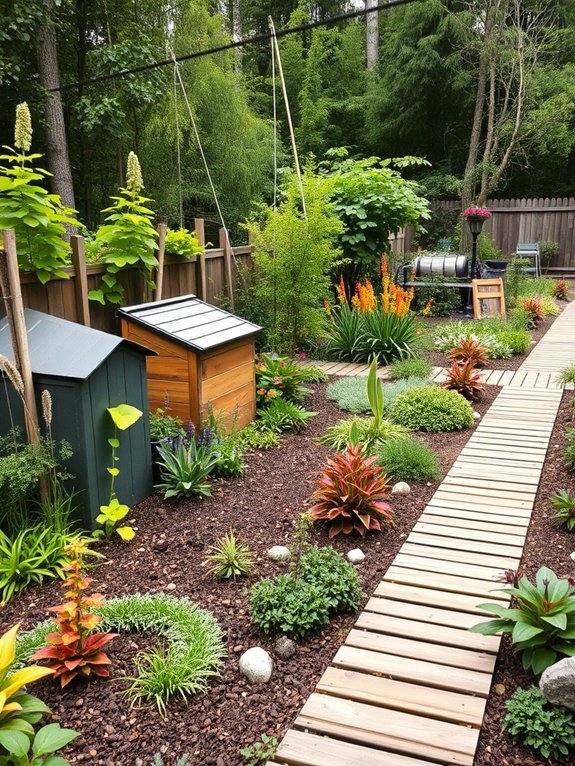
While you cultivate your garden, embracing permaculture principles can revolutionize the way you interact with the environment. By prioritizing sustainability, you create a harmonious space that nurtures both flora and fauna. Use companion planting to maximize growth and deter pests; for instance, pair tomatoes with basil. Your garden design should mimic natural ecosystems, enhancing biodiversity and soil health.
| Permaculture Principle | Action to Take |
|---|---|
| Observe and Interact | Study local ecosystems |
| Catch and Store Energy | Utilize rainwater barrels |
| Self-Regulate and Accept Feedback | Monitor plant health |
| Use and Value Diversity | Plant native species |
Implementing these principles will transform your green space into a thriving, eco-friendly refuge.
Add a Drip Irrigation System
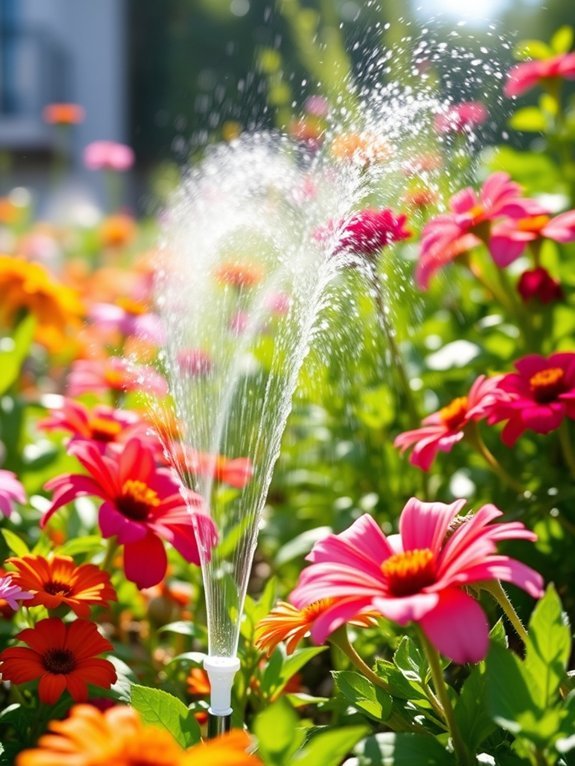
How can you guarantee your garden stays hydrated while minimizing water waste? A drip irrigation system is your answer. This efficient setup delivers water directly to the plant roots, ensuring they receive just the right amount. Here are three benefits:
- Water Conservation: By targeting the roots, you greatly reduce evaporation and runoff.
- Cost-Effective: Using less water means lower utility bills, saving you money in the long run.
- Healthier Plants: Consistent moisture levels help prevent overwatering and promote strong root growth.
Setting up a drip system is simpler than it seems. With a bit of planning and investment, you’ll nurture a thriving garden while embracing eco-friendly practices that respect the Earth. It’s a win-win for you and the environment!
Incorporate Natural Fiber Textiles
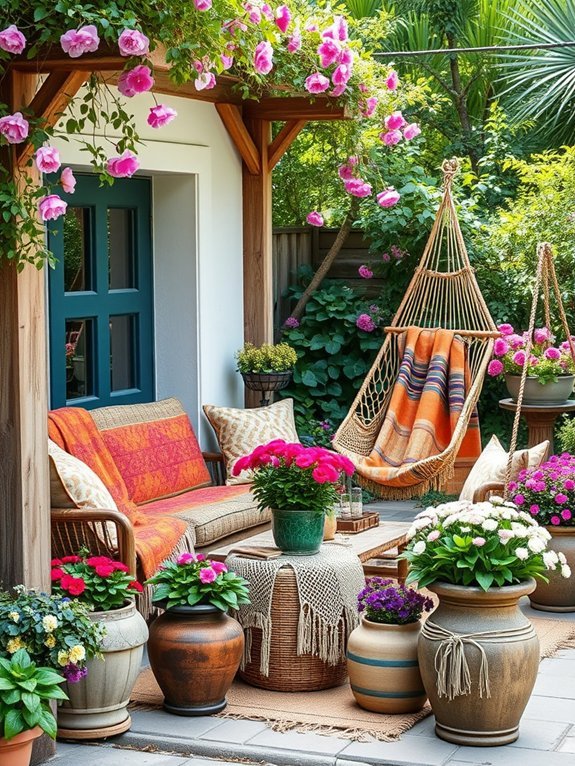
After ensuring your plants receive just the right amount of water, it’s time to enhance your garden’s aesthetic with natural fiber textiles. Using materials like jute, cotton, and linen, you can add a touch of warmth and style while keeping your garden eco-friendly.
Here are some ideas to inspire you:
| Natural Fiber | Suggested Use | Benefits |
|---|---|---|
| Jute | Garden burlap sacks | Durable and biodegradable |
| Cotton | Tablecloths for outdoor dining | Soft, comfortable, and versatile |
| Linen | Plant hangers | Strong, yet elegant |
| Hemp | Garden aprons & gloves | Naturally resistant to mold |
| Bamboo | Shade covers | Lightweight and sustainable |

